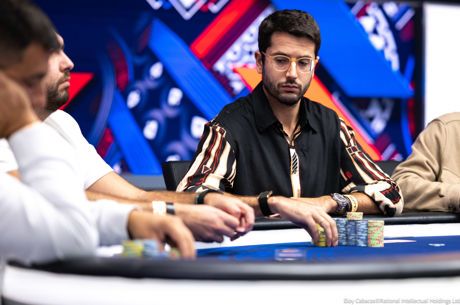Introduction to Omaha Part VII - Flushes

Tony is a regular on-line player living in England. He mostly plays Texas Hold'em and Omaha (High and Split) at fixed, pot and no limit, at both cash and tournament tables. Tony says: "I often play lower stakes games because there is money to be made without excessive risk to your bankroll. Many players I come up against at these levels are not schooled in poker strategy and the truth is they are giving away money, either through ignorance of strategy or misplaced aggression. If you have a limited bankroll, you should be conservative and choosy but the pickings are there. These articles are written to prevent you becoming one of the hunted."
Introduction
In my previous articles in this series, I have focussed on the basics of your starting hands, driving home the importance of having minimum standards for entering a pot. Your overall profitability depends on your maintaining these standards. It is simply not good enough to enter a pot time and again with raggy cards that just happen to contain a pair of jacks or a suited couplet like Qh 4h if your other two hole cards are random bus tickets. You might hit a top hand once in a while but that will not compensate for the losses you will suffer with such cards most of the time.
Often, good Omaha starting hands will be dictated by the card denominations, usually because they form part of a straight across all four of your hole cards from which you can pick and choose a variety of attacking options once the flop has come down. It is less likely that the criteria for entering a pot will be dominated by the possibility of making a flush, and there are good reasons for this. Flushes play a subsidiary role in Omaha hole cards and you need to be aware of the factors that can affect whether a play is worth pursuing when you are dealt suited cards.
How Good is a Flush in Omaha?
You will know of course that if you are dealt hole cards of four different suits, you absolutely cannot make a flush hand in Omaha. If you hold the Ace of Spades as your only spade, a board with four spades does nothing for you. It may be a nut flush in Texas Hold'em but it is as worthless as Ace High in Omaha. Your showdown poker hand always uses two cards from your four hole cards.
If you receive two cards of the same suit and one card each of another two suits in your hole cards, you at least have the makings of a flush providing three more of that particular suit are included on the board of five community cards. The odds are still not in your favour to make the flush. Here is an example:
Qh Jd 8h 4s
You have two parts of a Q high flush as it stands. If the board shows three more hearts, you have made a flush. Say it comes down
7h 8d 2h Jh 5s
At showdown you have a Q flush. This seems promising but if you still had competition at the betting after the turn you would start to worry. If there is a made straight out there, you will be happy with that as you have it beat. The big danger is that someone is holding two hearts also and one is the K or A. Then you are in trouble. If he has raised the betting, you will have to make a judgement about the player and whether he is a rock who only bets the nuts or whether it is someone who might overvalue a middle-ranking flush or straight.
This is Omaha poker in a nutshell. Both the holder of a made straight and a middle-grade flush will bet in trepidation of a superior hand. This is a direct function of everyone holding four hole cards. The odds of someone making a nut hand are vastly superior to the odds of achieving one in Texas Hold'em.
This also reinforces why you should be strict in your standards for starting in a pot. Compared to Texas Hold'em, a Q flush is relatively weak. Whenever there are three cards of the same suit on the community board, there is a chance someone is holding a high flush. At the very least, you need to factor in the likelihood of this when deciding to bet or raise with a middle-sized flush.
Two is Better than One
Like all starting hands in Omaha, you want your hole cards to yield the greatest possible combination of strong hands. If you could have the chance of flushes in two different suits, you would prefer it over just the one. However, unlike combining a group of hole cards for a straight (say, Q J T 9, which can combine in six different groups of two), a flush needs two cards of the same specific suit to qualify. Therefore, to have the choice of two possible flushes requires that your hole cards be double-suited; that is, they must comprise two cards of one suit and two cards of another suit. That is a maximum of only two combinations for flushes compared to six for straights.
This illustrates why a flush is a subsidiary driver in deciding whether to bet a starting hand. The ideal situation is to have starting cards dominated by high cards and/or straight sequences with an added bonus being that the combinations are also double-suited.
It is probably fair to say that the only time when your starting hand decision should be based primarily by the suits is when you have a double-suited combination and the highest denomination of both suits is at least a K. For example, a hand to see a flop with would be:
As Ad 9s 5d
Superficially, the AA combination will attract all-comers but, without the support of the double-suit, the hand lacks a lot of potential because there is no chance of a nut straight being made. That would leave the isolated pair of aces as the only possible source of salvation requiring one of the two remaining aces to hit the board. Against up to nine opponents on a fixed-limit table, your hand would struggle to survive a coordinated flop unless you make a full house.
However, with a double-suited pair of aces, you have two shots at the nut flush and that makes this hand a bet before the flop. Of course, the flop ideally needs to come down with at least one of each suit, ideally two of one and one of another to maximise your chances of catching whilst not scaring off the opposition - as would happen if you make your flush directly at the flop when all three of one of your suits appears.
You would probably bet likewise with a KxAx or KxKx double-suiter but any less than that and you start to invite trouble. It is not abnormal for someone's K flush to be beaten by the A flush, so a Q or J flush is a relatively weak proposition unless your other cards are nicely coordinated for straights or perhaps double-paired, such as:
Qh 9c Qc 9h.
Here you are betting for full house and straight potential. The double-suit is a welcome back-up.
Three's A Crowd
So, you need at least two of a suit in your hole cards to earn some back-up for your hand. So far so good. How do you feel then when three cards of the same suit appear in your hole cards? What about all four being of the same suit?
One thing you can say is that the hand looks pretty but what does it also tell you? The answer is not good news. To make a flush, your two suited cards have to be added to three on the board. That is five cards from a maximum thirteen in the deck. There are 1,287 ways of combining any five cards from a set of thirteen. If you are double-suited, you double your chances immediately to 2,574.
If you have three of a suit in your hand, there are now only twelve of that suit in play because the lowest of the three in your hand is not playing. You will combine the higher two with three on the board. There are 792 ways of combining any five cards from twelve. That is only 61% of the optimum position.
If you have four of a suit in your hand, two are dead leaving eleven in play. There are 462 ways of combining five cards from eleven. That is only 36% of the optimum position.
These figures speak for themselves. You cut your chances of successfully making a flush by a large amount if you bet when receiving three or four cards of the same suit in your hole cards. Also of course you can never be double-suited.
Conclusion
Flushes will always beat straights. Consequently, many players bet flush draws with abandon in Omaha poker. They will do this whether or not they hold a high card in the hole and regardless of the number of the same suit they hold in the hole. Yet, as I have discussed above, there are major leaks in a game played that way when you are on a full table at fixed-limit Omaha.
Flushes should usually be regarded as a subsidiary driver in the decision to play a hand. If your cards cannot support themselves without a flush back-up, they are probably not playable even with flush possibilities. The exception is a double-suited hand where both suits are nut or near-nut possibilities.
When you receive three or four of a suit in your hand, you should not base a decision to bet on the flush because of your narrowed odds. You should bet on the merits of the hand ignoring the suits.
Like all poker games, you should (to an extent) relax your starting standards if, and only if, the game becomes short-handed. If there are only four of you at the table, the odds on more than one person holding a flush are much reduced.
Exorcism
17 May 2005
ED Note: Now you really want to play Omaha, but you own a Mac? No problem, play at Poker Room.com









